 |  |
By David Kier
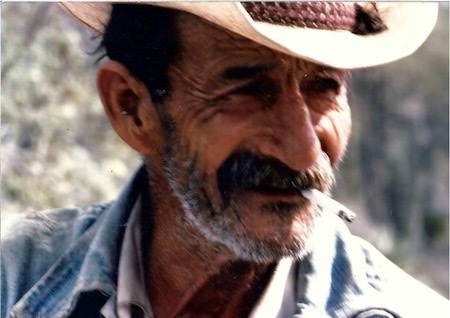
Don Eliodoro Arce was a friendly old prospector who lived alone but was never lonely. He was universally loved by all who knew him, living near the abandoned gold mine of El Desengaño, along the older road to Bahía de Los Angeles. Eliodoro Arce Villavicencio was born in 1912, one of five children of Sr. Primitivo Arce and Refugio ‘Cuba’ Villavicencio. He passed away in the year 2000 at the home of his younger sister in Nuevo Rosarito. Eliodoro was 87 when he died. Learning about Eliodoro and his family has been nothing less than an amazing discovery for me.
Eliodoro’s kindness was well-known by those who met him. Besides his gold prospecting he also collected honey. That caused Herman Hill (1921-2013) to call him the Bee Man. Herman was an American who lived in Bahía de Los Angeles and also prospected in the hills of central Baja California. Herman’s stories are in the book, Baja’s Hidden Gold.
Phil Niles wrote about Eliodoro on the Baja Nomad forums: “I found him on the old northwest road, from Bahia de Los Angeles to Highway 1, a few miles NW of the Desengaño mine. He was friendly, showed me around, and invited me for coffee. He lived in a thatch-roof, cardon-rib shack complex with an early 70’s Corvair station wagon body spliced in. He had no running car or animals”.
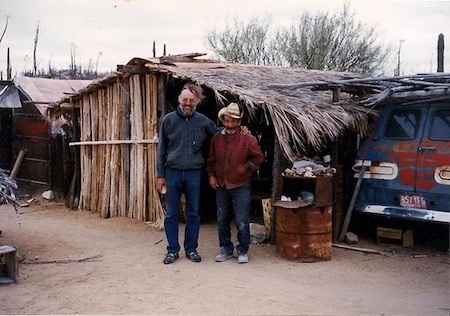
Phil continues: “I visited Eliodoro a few times over the years thereafter. I’d bring him cigarettes, instant coffee, and some canned food, but he never seemed to want or need anything. We’d talk sitting around his fire and coffee pot. He said he never drank water, only coffee. We did some walks. Over time I collected various cactus skeletons from him, including a cardón boot. One afternoon we had a party when two of his nephews showed up with ceviche, beer, and comradery. I think one had a tire shop in Tecate, and the other managed a store in a U.S. border town”.
Baja fishing and prospecting friends, ‘Mando’ Gallego and Ivan Fortin, were greatly touched by this desert hermit. Mando begins the story:
“‘CAFÉ! CAFÉ’! It’s only fitting that he started with that greeting. Those were the first words Eliodoro uttered every time we pulled up to his casita. Didn’t matter what time of day it was…there was always a pot of coffee on the embers. That was and will always be the best ‘cowboy coffee’ around!
“Eliodoro was many things...most of all he was in-tune with life. A minimalist. He showed Ivan and me that less is more. Not because he lived alone...he had many friends: The coyote who would sit close to us during morning café, and the little bird who would perch on his shoulder. Time spent with him was always a treat. I would like to share these adventures of Eliodoro so that he will never be forgotten...”
Next, we hear from Mando’s friend, Ivan:” ‘Café Compadres, Café Compadres’!!! Four words at our first meeting from a man running outside his small house, waving for us to stop and visit. My friend Mando and I had no idea that those four words would start six years of extraordinary adventures and a lifetime love of Baja.
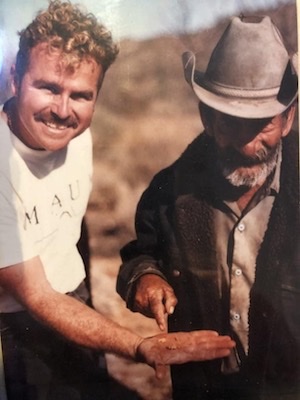
“Eliodoro Arce, living quietly amongst the solitude of the Central Baja Region, miles from any town or market. Eliodoro was a walking encyclopedia of Baja’s Central Desert Region, its early history, plants, waterholes, Indian life, geology, and gold producing districts. He lived a minimalist life without a car, electricity, or amenities. We would ask, ‘What do you do when you run out of food’? He would proudly point out the surrounding plants and area, almost as if we should have known.
“He would join us on gold prospecting adventures, always producing a few gold nuggets at every place. Meeting Eliodoro was like stepping back in time, a time long forgotten. To this day I miss our visits with him and still have many questions. He taught us to embrace the quietness and solitude of the desert. He was short in stature but had a hearty soul, filled with compassion, kindness, laughter, and a great love of Baja.
“On his deathbed he scolded us for visiting him, and not out there prospecting. Mando and I were able to say our last goodbyes. A final goodbye to the adventures, the cowboy coffee, by-the-fire, and the vast knowledge he loved to share. [Eliodoro died the very next day.] When Eliodoro passed away, the Arce family lost its cornerstone, and we lost our friend.” - Ivan Fortin.
It was now important to learn as much as I could about this colorful character, Don Eliodoro, who was admired greatly by those who had interactions with him.
One of Baja California’s most dedicated researchers was Howard Gulick, who made accurate maps and detailed road logs for his Lower California Guidebook (with four editions and printings from 1956 to 1970). Mr. Gulick was an engineer for the City of Glendale, California. He spent his free time driving and photographing the peninsula, long before paved roads existed in most of Baja California. The photos Howard took are preserved online and they serve as a wonderful look back in time. Howard has seven photographs that name and include Eliodoro Arce, all in 1961.
In 1967, historian and author Harry Crosby, while riding mules on El Camino Real, paused at Mission San Borja to photograph Eliodoro’s uncle, Jorge Arce Villavicencio. Harry would go back to Baja California many more times to research El Camino Real, mission history, cave paintings, and the Arce’s (as well as other mountain ranch families). I studied the beginnings of the Arce clan, as they were presented in Harry Crosby’s 1981 book, Last of the Californios.
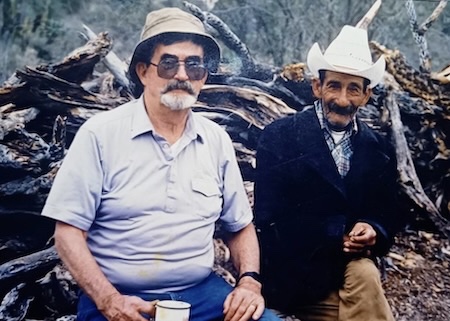
Upon publishing my Eliodoro webpage and sharing it on my ‘Baja California Land of Missions Book’ Facebook group, I was immediately contacted by Eliodoro’s relatives! They are all on the Internet, even from their remote Baja California ranchos. I began getting stories and photographs about their uncle, Don Eliodoro.
Eliodoro’s father, Primitivo Arce married twice. His first wife (and Eliodoro’s mother) was Refugio Villavicencio. They had five children. Primitivo’s second wife was Mercedes Villavicencio Gaxiola, daughter of Fidel Villavicencio and Trinidad Gaxiola. The second marriage also produced five children, all daughters: María Luisa (Licho), Guadalupe (Lupe), Mercedes, Teresa, and Isabel.
In the new webpage, I will include some of the family's history and photos (which is still being edited and added to).
The children and grandchildren (who write to me) come from the five daughters of Primitivo and Mercedes. Their emails and messages are joined by those from the grandchildren of Eliodoro’s aunt, Salomé Arce, and her husband Jesús Zúñiga.
One of the first relatives to contact me was ‘Jimy’ David Torres, of Rancho San Luis (grandson of Eliodoro’s sister, Mercedes Arce). This was the ranch of Eliodoro’s father, Primitivo Arce. It dates back to about 1850. San Luis is located in a mountain meadow of the Sierra de San Luis, but most know it as the Sierra de la Asamblea. In Erle Stanley Gardner’s 1961 book, Hovering over Baja, the old, ruined home of Primitivo Arce is pictured on page 226. Gardner, with his Perry Mason creative imagination captioned that it “may well be the Lost Mission of Santa Ysabel".
Torres writes, “Nana Mercedes told me that my uncle Eliodoro was the most nomadic. He would leave the San Luis ranch for days and return and supply them with honey and deer meat, and he would go back through the mountains”.
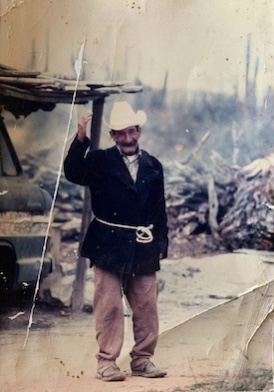
Jimy Torres then speaks about the mountain range name, “The sierra is connected by corridors between the mission of San Borja, and to the north, with Calamajué. Now it is very common for many people to call the Sierra de San Luis as the Sierra de la Asamblea, but the first name is Sierra de San Luis. Later they named it the Sierra de la Asamblea. A little higher up to the north, it is assumed that the old Cochimí Natives used to meet in that part. They revealed themselves to the evangelization by the Spaniards, which is why they called it 'The Assembly'.”
Leticia Peralta Maciel tells us, "I had the pleasure of listening to Uncle Eliodoro's talk, a man who knew how to live in the desert". [Leticia tells us she guided Phil Niles and his wife to visit the grave of Eliodoro.]
Elizabet Meza Arce tells us, “Eliodoro never married or had a child. He lived happily in the mountains. He didn’t like being around people''. One of Elizabet’s brothers visited Eliodoro often and he brought Eliodoro groceries. “We only saw Eliodoro when he went down to the ranch where we lived. My uncle Eliodoro’s paternal grandparents were Marcelino Arce and Cleofas Villavicencio. When I read [the webpage] about the ‘Bee Man’, I also remembered that my mother used to say that when they were girls my uncles Eliodoro, with his brother Marcelino, would go hunting and get honey for them to eat.”
It is this kind of great Baja story-telling that really makes my heart glow, learning and sharing stories about the land, the people, and the history!
Baja California is truly the land that keeps on giving!
Editor's Note: Congratulations to David Kier on his 100th article for Baja Bound! Thank you for all of the years of amazing stories and adventures!
About David
David Kier is a veteran Baja traveler, author of 'Baja California - Land Of Missions' and co-author of 'Old Missions of the Californias'. Visit the Old Missions website.

Great insurance! Bought one year but was cured in 2 days on my visit to El Sauzal de Rodriguez next...

I have not had any claims thus far so rating is based on ease of purchase.

Thank God I had a safe trip but it did have me at peace knowing I was fully covered. The staff were...